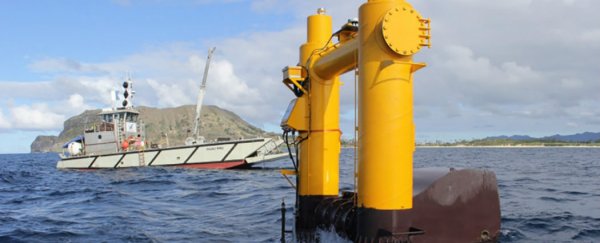The US has started receiving power from wave energy for the first time, thanks to a prototype wave generator called Azura.
Installed off the coast of Hawaii at the US Navy's Wave Energy Test Site in Kaneohe Bay, this 40-tonne, bright yellow device is the first of what the national Department of Energy (DoE) says could be a fleet of wave generators working together to supply clean, renewable power to America's coastal cities. With 50 percent of the population living along 80 kilometres of coastline, the potential is huge, if they can get it right.
The Azura prototype was installed 300 metres below the surface last month, and has been generating power ever since, but this week is the first time the amount has actually been verified.
While the amount was pretty minuscule - 20 kilowatts - the Oregon-based company behind the design, Northwest Energy Innovations (NWEI), says the design will be improved and the new iteration will be installed deeper and in the vicinity of much bigger waves, giving it the potential to generate 1 megawatt of power, which Steve Dent from Engadget says will be enough energy to power several hundred homes.
The key to the success of the Azura design is in how it manages to capture all aspects of movement in a wave, which the DoE says marks a radical shift in how wave energy devices operate. "Waves have both side-to-side and up-and-down motion, but up to this point, almost all designs have been limited to one direction or the other," says the DoE website. "The Azura can harness movement in 360 degrees, bobbing, twisting and wobbling its way to a higher electricity output."
The team plans on installing the new megawatt-capable system in 2017, and in the meantime will keep testing their Azura prototype with the help of the US Navy. Meanwhile, a similar device has been installed off the coast of Western Australia, and has been supplying wave energy to the local grid since February.
According to World Ocean Review, the global potential of wave energy is estimated to be around 11,400 TWh per year, with the potential for that to be converted into some serious useable energy. "Its sustainable generating potential of 1,700 TWh per year equates to about 10 percent of global energy needs," the Review States. If we're smart, we'll get on that sooner rather than later.
